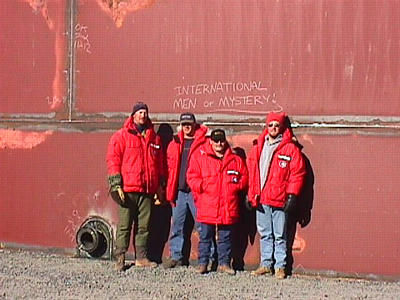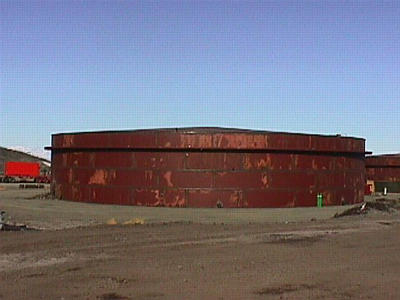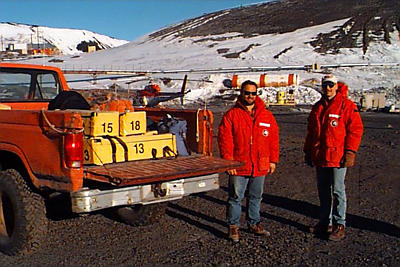
|
|
30 November, 1998
Monday, November 30th, 1998
Hi! The last day of November….where HAS the time gone? At our general
meeting for Cape Roberts this morning, Peter Webb discussed the plans for the
next 10 days. Science teams are all working on their initial reports for this
drilling season of the Cape Roberts Project. Many of the people from the Cape
Roberts drill site are arriving in McMurdo and over at Scott Base this week.
Field trips, by helicopter, to the Dry Valleys of Antarctica commence tomorrow
evening. I am scheduled to be on that first field trip.
I spent today's lab time finishing ALL of my labeling and measuring the last
samples for their magnetic susceptibility. After being involved with
sampling, labeling, and measuring about 1,000 small cores and plastic boxes, I
felt a huge sense of accomplishment. I will continue to help in the lab with
the demag machine and re-packing samples in the small plastic bags that are
labeled. There's a lot of work to be done before we can call it quits in the
paleomag lab.
This morning I got up early and walked uphill to the site of the new fuel
tanks. The welders (they call themselves "tankies" since they build all sorts
of tanks) finished the new tanks on Sunday and are set to fly out of MacTown
on a cargo flight tomorrow morning. I wanted to get some photos of the
completed tanks, and some of the guys who worked on the project. They ended
up being way ahead of schedule, and finishing up before their original mid-
December departure date. It has been neat to follow this project from start
to finish. These are HUGE tanks and they went up so fast! Two more tanks are
scheduled to be built during next summer's work season. There's all sorts of
construction going on around McMurdo!
I spent the rest of today working on journals and e-mail, and THAT took hours
and hours. In the next few days I'd like to highlight the different groups of
scientists working on the Cape Roberts Project. As each group summarizes and
finishes work on this drilling season, it makes sense to introduce them to
you, tell you about their part in the project, and give a brief summary of
their results.
I'm going to start with the curators, Tom Janecek and Matt Curren. Their job
is a very important one, since they are "in charge of the core" and it is
their responsibility to handle it once it arrives in McMurdo, and after it is
stored in the Antarctic Marine Geology Research Facility at Florida State
University in Tallahassee, Florida. Tom and Matt see that the core is
properly sampled, and they do the sampling for all science teams, other than
the paleomag group (we drill our samples). They have to package and store the
core boxes here in McMurdo…package them for shipping to the United States (for
the archive half…remember the working half goes to a storage facility in
Germany). They use wooden crates, built by the carpenters during the winter
over season in Antarctica, and pack 36 corrugated cardboard boxes of core in
each sturdy wooden crate. This is 1,200 pounds of core! The wooden crates
have shelves and 4 boxes of core can fit into each compartment.
The crates are shipped back to the United States once the vessels arrive in
McMurdo later in the summer season. They are stored in refrigeration the
entire time. There are two reasons for this…one, it keeps down mold growth
(there is organic material in the core), and two, the core is stored near the
temperature the material was accumulated in. Once the ship arrives on the
west coast, the crates are transferred to refrigerated trucks and transported
to Florida.
At the Antarctic Marine Geology Research Facility, Tom and Matt are curators
in a facility that has 5 to 6 thousand square feet of refrigerated space.
There are 6,000 cores, which is 20,000 meters…which is 60,000 feet…which is 12
MILES of core…stored in this facility. Most of the cores are taken from ships
and are deep sea sediment cores from the southern oceans surrounding
Antarctica, but there are also cores from Cape Roberts 1 (last year's
project), CIROS (Cenozoic Investigation of the Ross Sea) from back in the
1980's, and from drilling in the Dry Valleys (specifically Taylor Valley) back
in the 1970's.
I think that the job they have is quite interesting. They have to interact
with all members of the Cape Roberts Project, now and in the future, (if
someone wants to have samples from the archive half of the Cape Roberts
cores). Thanks guys for the interview! If you want more information about
the Antarctic Marine Geology Research Facility, check out their web site:
www.arf.fsu.edu and learn some more about geology!
Talk to you tomorrow!
Betty :)

(from left to right) Daniel Gylten, Jim Viele, Ryan Savage, and Tom Ehnstrom...4 of the 14 men who worked on welding the fuel tanks together. Daniel, Jim, and Tom are from North Dakota, and Ryan is from California.

One of the two new fuel tanks in McMurdo.

(from left to right) Matt Curren and Tom Janecek, core curators for the Cape Roberts Project. They are picking up the last shipment of cores sent in by helicopter from the Cape Roberts camp to McMurdo.
Contact the TEA in the field at
.
If you cannot connect through your browser, copy the
TEA's e-mail address in the "To:" line of
your favorite e-mail package.
|
